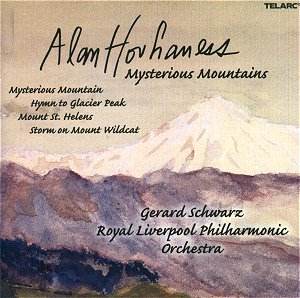The Hovhaness musical legacy is numerous and
still largely inaccessible. There are more symphonies unrecorded
than there are recorded … although that margin is narrowing.
Hovhaness's catalogue is littered with references
to mountains. Examples abound: Symphony No. 46 To Green Mountains
(recorded on Koch by Vakhtang Jordania), Symphony No. 13 Holy
Mountain, Symphony No. 57 Cold Mountain, Mountains
and Rivers Without End and the various piano solos including
the Mount Katahdin sonata. Indeed the symphony which brought
him a major recording contract has a title which combines two
potent elements in the Hovhaness vocabulary; mountains and mystery.
The work was commissioned by Stokowski after his success with
the First Symphony The Exile. Reiner recorded it with the
Chicago orchestra. Amongst modern recordings the competition includes
an earlier version in which Schwarz conducts the Seattle Symphony
(Delos DE 3157). You might also come across the Musicmasters CD
on which Dennis Russell Davies directs the American Composers
Orchestra. The latter was made in 1988: the Delos Schwarz in 1993.
The Musicmasters disc is forwardly recorded but
the strings have a thin edginess that sits uncomfortably with
this music of exaltation. The Delos sounds ample, close and luxurious
by comparison. Silky textured it may be but not sybaritic. On
Telarc Schwarz, a decade after the Delos sessions in the presence
of the composer, takes almost two minutes more in the first movement
andante con moto than on the Delos disc. The other two
movements are about the same time - well maybe a second or five
longer with the RLPO. If the issue was only Mysterious Mountain
I would recommend the Delos disc where the music of the first
movement is more in touch with the 'con moto' marking.
Mysterious Mountain is smoothly
contoured. There are no horrors or chasms; no nightmares or jagged
cliffs. The music proceeds with liquid flow, like some beneficent
answer to prayer, a benediction in comfort, a balm and healing.
This is all articulated from the vantage point of Vaughan Williams'
Tallis Fantasia. There is no 'barkbrod' in this music,
no saltpetre or bile. Schwarz communicates this more directly
in 1993 (Delos) than he does in 2003 and the Seattle players sound
velvety - a most refined yet powerful recording. Nothing serious
amiss with the Telarc and glowingly representative of the work.
It is just that the Delos sounds that much better.
Hymn to Glacier Peak is his last
but one symphony. Initially this sounds similar to Mysterious
Mountain but seraphic birdsong intervenes contrasting with
the leathery nightmare chorus to be heard in Symphony No. 23 Ani.
Birdsong also sings through the Love Song to Hinako middle
movement. This echoes the coloratura voice of his wife Hinako
Fujihara well known from recordings of earlier works. A dissonant
chime sequence, oft repeated, appears in the final movement along
with a 'sword wind' fugue typical from the Ninth Symphony (St
Vartan) onwards. The music has the powerful surging ebb and
flow of Vaughan Williams' Concerto Grosso for massed
strings.
The Mount St Helens symphony dates
from 1982, two years after the most photographed eruption of all
time. This is another flowing work but with very strong melodic
interest especially for the woodwind. The second movement, Spirit
Lake is alive with the chime of bells suggestive of worship
and praise, together with his trademark pizzicato delicacy. There
is also strong melodic material as in the oboe song at 1.22. The
'eruption' when it comes is groaned out by percussion and shuddering
strings (2.19) with braying, snaking and somersaulting trombones
(2.46) straight out of the phantasms of Symphony No. 19 Vishnu.
Storm on Mount Wildcat is a rare
survival from the 1930s. The composer had destroyed most of his
work from that era in a bonfire of manuscripts. This survived.
The noisier parts of it remind me of two orchestral preludes to
The Tempest: Sibelius's and, a step or two closer to onomatopoeia,
Gösta Nystroem's. The element of aural naturalism is offset
by a weaving temple dance.
The composer’s widow, Hinako Fujihara, has done
much to promote the composer’s music, singing in Celestial
Canticle, Presentiment, Kanuko, Mysterious
Harp, arias from the opera Pericles, the Sonata for
soprano and harp, Symphony No. 38 and others. Mention of Fujihara
and her aspiring celestial coloratura reminds me that two LP recordings
from the 1980s appear never to have been reissued on CD. One involves
Fujihara’s singing. It was the Symphony No. 47 titled Walla
Walla played by the Walla Walla Symphony Orchestra conducted
by Ray Lee Fiese. Fujihara was the singer. This, and another Hovhaness
symphony LP, also from the Fujihara Record Company, seem never
to have been reissued on CD. I do hope that someone will return
to these recordings and make them available again.
While some find Hovhaness unvarying others will
sense considerable healing in the spiritual wings of these works.
This Telarc disc is a generous way of experiencing his approach
to the symphony, recorded and played magnificently ‘just down
the road’ from this reviewer’s home. I wish I had known when the
sessions were taking place.
Rob Barnett
